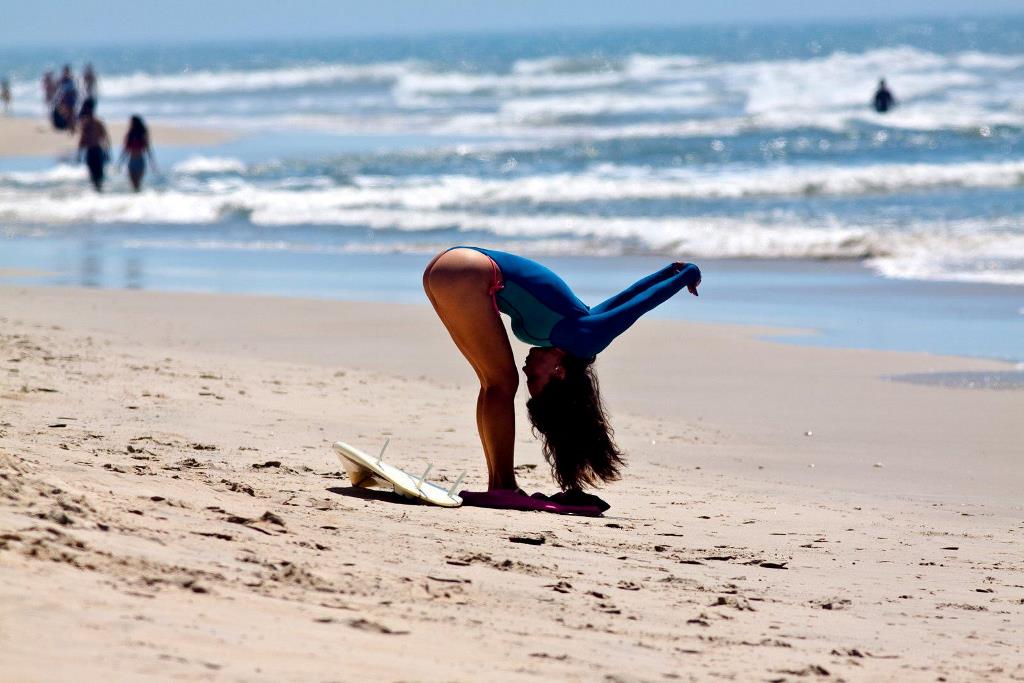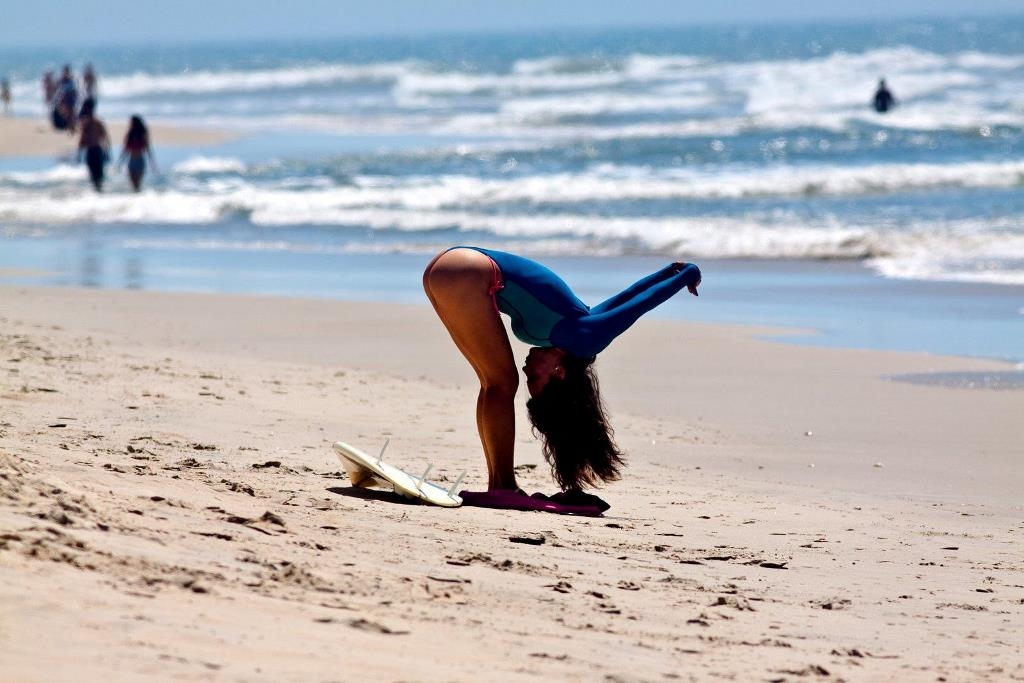Words Glenn Phillips – Exercise Physiologist at The Movement Lab
 So, is she actually doing anything good for herself here? Or is this the placebo affect?
So, is she actually doing anything good for herself here? Or is this the placebo affect?
I’ve always been in awe of pre-surf routines. I recall as a grommie, sitting out in the line-up watching one of the older locals prep for every surf as though he was looking to back up his New York Marathon world record. Now, as I approach the shadier years of my life, I understand his reasons for such an extensive routine, though I’m not totally sold on his methods.
My beachside observations of various individuals have led me to place their corresponding pre-warm up routines into 4 categories:
The Old-School
Typically recognised through being old, the old school proponent is typically seen stretching his arm across his chest, followed by a few good old fashioned forward bends. A quick jog along the beach tops off this time-tested, though relatively useless routine.
The Yogi
The yogi kicks off his routine by tying back his dreddies or firmly adjusting his top knot, before launching into a dazzling array of flowing downward dogs and inappropriate headstands. He gracefully flounders into the water with the type of bendiness that would make a gumby feel like he had stage 2 arthritis.
The Crossfitter
The crossfitter is recognisable through the fact that he has a crossfit shirt on and exits the car talking about his latest PB and the WOD he just smashed. Opening the boot, he pulls out his holy grail—the foam roller, and proceeds to roll his back up and down the foam roller with the sentiment and dedication of some sort of twisted call to prayer.
The Ne’er Sore
The ne’er sore is one of those guys who is never tired, sore or injured. Despite falling 3 stories from a balcony the preceding evening, he rocks up at 5:30am to shred more than his fair share in the line-up. Warmup generally consists of putting on a wettie in the cooler months, or scraping the fingernails across the wax in the warmer months. Typically recognised through a lack of, or newly sprouted, pubic hair.
So which one is the best option? You might note from the cynical undertone, that I’m not a fan of any of these processes as a stand-alone, as the best pre surf routine should be based on principles that relate to the individual, rather than fashioned on popular methods or mimicking what someone else does, in some other sport or activity.
Now this? This is surf preparation at its finest.
But the big questions is – should you stretch before you surf?
You may have heard that this is a big no-no. ‘Stretching is dead’ cry the masses, though reasoning as to why this is so, seems to be less vocalised. This news has been abuzz in the health and fitness industry for some years, and has tended to become “common knowledge” thanks to mainstream media jumping on board in recent years.
This news came out of studies some twenty years ago that found that stretching before exercise reduced the muscle’s ability to produce strength and power, results which have been replicated many times since. Without going into this too deep, the majority of these studies have looked at how stretching has impacted vertical jump height, a commonly observed test of the ability to generate power.
In regards to this, I often ask my athletes is the goal of each session that they partake in to produce maximal power? And I ask this question across the board to all sports. It’s logical to apply these concerns to a competition where maximal power is important, but generally as athletes train and practice, the ability to produce maximal power will sparingly be the primary goal in a well periodised program.
And all the while, we have stuff like this – Inertia’s Fit2Shred program. Does THIS actually do anything?
Studies since have shown that these findings don’t apply to stretching durations of under 30 seconds, with stretching duration of longer than 60 seconds more correlated with decreases in performance, though the correlation factor here is still only around 61% (read more here if you so desire).
The debate isn’t as clear cut as I lay it out here, but it is a good indicator that it’s best to look at all of the evidence before taking on board any advice in the health and fitness industry. Outside of this, it’s worthwhile thinking about this with some sense of logic as well.
Let’s say for example, that you have an incredibly tight chest (too many bench presses Arnie), and know that when you surf, this gives you issues paddling. Your shoulders roll forward, and you get pain in your neck, from having to hyperextend due to the knock on effect of a lack of thoracic mobility. Would it make sense to stretch out the chest a little, to help free up some movement? Even if you did look at one side of the evidence that indicated the corresponding loss of power, I would err on the side of increasing efficiency and reducing potential pain and injury, through allowing my body freedom of movement and efficient muscle contraction.
Well and good, but I haven’t really answered the question. Put simply, I advocate stretching if you have reason to stretch. I feel the whole ‘let’s just run through an overall stretch’ shindig is generally a bad idea. Stretching needs to be targeted. Especially as surfers, many of us have muscles that are chronically tight, with opposing muscle groups unequally lengthened—these are usually the ones that people stretch due to ease, and the general satisfaction you get from feeling like you have hit hard-core yogi status, through stretching out the already elongated muscles. Ironically, this can help to increase your injury risk.
So stretch what’s tight if needed, pre and post surf. If your one of the lucky few that has the perfectly aligned body, then a general warmup, or easy paddle out is probably enough to see you into your next shredfest.
–––
Glenn Phipps is an in demand Exercise Physiologist who currently works with the world’s best athletes in SUP, Surfing, OCR and MMA. He is also the official Sports Scientist for the ESPN program Search 4 Hurt, and has been featured in various health and fitness publications. When not bringing clarity to the confusing world of health and fitness, he can be found lamenting why everyone wants to surf at the same time as him, and hanging out with the people he made.
You can find out more about Glenn and his business, The Movement Lab, right here. Or, find him on Facebook. And, stay tuned for his next article as Surfing Life’s in house health expert.



